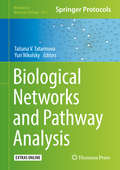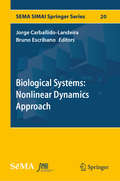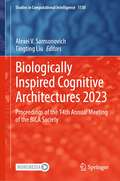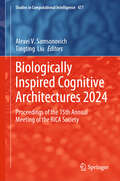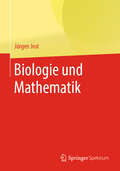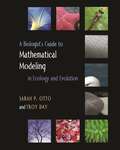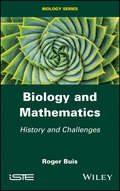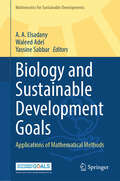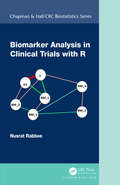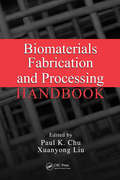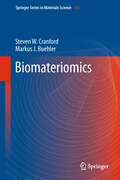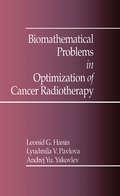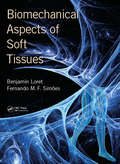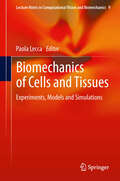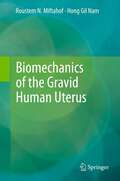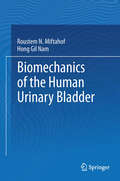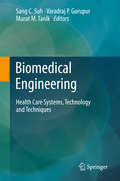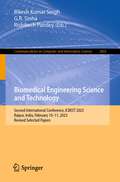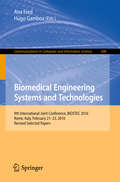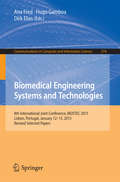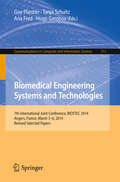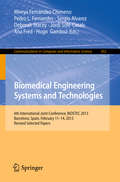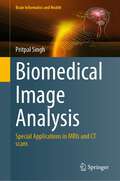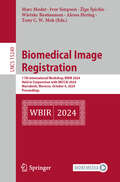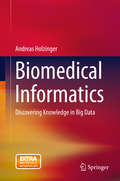- Table View
- List View
Biological Networks and Pathway Analysis (Methods in Molecular Biology #1613)
by Yuri Nikolsky Tatiana V. TatarinovaIn this volume, expert practitioners present a compilation of methods of functional data analysis (often referred to as "systems biology") and its applications in drug discovery, medicine, and basic disease research. It covers such important issues as the elucidation of protein, compound and gene interactions, as well as analytical tools, including networks, interactome and ontologies, and clinical applications of functional analysis. As a volume in the highly successful Methods in Molecular Biology series, this work provides detailed description and hands-on implementation advice. Reputable, comprehensive, and cutting-edge, Biological Networks and Pathway Analysis presents both "wet lab" experimental methods and computational tools in order to cover a broad spectrum of issues in this fascinating new field.
Biological Systems: Nonlinear Dynamics Approach (SEMA SIMAI Springer Series #20)
by Jorge Carballido-Landeira Bruno EscribanoThis book collects recent advances in the field of nonlinear dynamics in biological systems. Focusing on medical applications as well as more fundamental questions in biochemistry, it presents recent findings in areas such as control in chemically driven reaction-diffusion systems, electrical wave propagation through heart tissue, neural network growth, chiral symmetry breaking in polymers and mechanochemical pattern formation in the cytoplasm, particularly in the context of cardiac cells. It is a compilation of works, including contributions from international scientists who attended the “2nd BCAM Workshop on Nonlinear Dynamics in Biological Systems,” held at the Basque Center for Applied Mathematics, Bilbao in September 2016. Embracing diverse disciplines and using multidisciplinary approaches – including theoretical concepts, simulations and experiments – these contributions highlight the nonlinear nature of biological systems in order to be able to reproduce their complex behavior. Edited by the conference organizers and featuring results that represent recent findings and not necessarily those presented at the conference, the book appeals to applied mathematicians, biophysicists and computational biologists.
Biologically Inspired Cognitive Architectures 2023: Proceedings of the 14th Annual Meeting of the BICA Society (Studies in Computational Intelligence #1130)
by Alexei V. Samsonovich Tingting LiuThe book focuses on original approaches intended to support the development of biologically inspired cognitive architectures. It bridges together different disciplines, including artificial intelligence, linguistics, neuro- and social sciences, psychology and philosophy of mind, among others. The chapters are based on contributions presented at the 2023 Annual International Conference on Brain-Inspired Cognitive Architectures for Artificial Intelligence (the 14th Annual Meeting of the BICA Society, BICA*AI 2023), organized in collaboration with the University of Ningbo and held on October 13-15, 2023, in Ningbo, China. The book discusses emerging methods, theories and ideas towards the realization of general-purpose humanlike artificial intelligence or fostering a better understanding of the ways the human mind works. It provides engineers, mathematicians, psychologists, computer scientists and other experts with a timely snapshot of recent research and a source of inspiration for future developments in the broadly intended areas of artificial intelligence and biological inspiration.
Biologically Inspired Cognitive Architectures 2024: Proceedings of the 15th Annual Meeting of the BICA Society (Studies in Computational Intelligence #477)
by Alexei V. Samsonovich Tingting LiuThis book reports on original approaches intended to support the development of biologically inspired cognitive architectures. It bridges together different disciplines, including artificial intelligence, linguistics, neuro- and social sciences, psychology and philosophy of mind, among others. The chapters are based on contributions presented at the 2024 Annual International Conference on Brain-Inspired Cognitive Architectures for Artificial Intelligence (the 15th Annual Meeting of the BICA Society, BICA*AI 2024), organized in collaboration with the 17th Conference on Artificial General Intelligence (AGI 2024) and held on August 13-16, 2024, in Seattle, WA, USA. They cover emerging methods, theories and ideas towards the realization of general-purpose humanlike artificial intelligence or fostering a better understanding of the ways the human mind works. All in all, this book provides engineers, mathematicians, psychologists, computer scientists and other experts with a timely snapshot of recent research and a source of inspiration for future developments in the broadly intended areas of artificial intelligence and biological inspiration.
Biologie und Mathematik
by Jürgen JostMit ihrer Vielzahl von erstaunlichen Phänomenen und ihrer komplexen Verwobenheit unterschiedlichster Skalen ist die Biologie die reichhaltigste aller Naturwissenschaften. Sie hat in den letzten Jahrzehnten die eindrucksvollsten Fortschritte erzielt. Aber Biologie und Mathematik sind sich traditionell fremd. Dabei kann die Mathematik die Biologie in vielfältiger Weise bereichern und unterstützen, von der logischen Klärung der Grundbegriffe über die formale Modellierung biologischer Strukturen und Prozesse bis zur systematischen Analyse riesiger Datenmengen. Für die Mathematik gibt es nicht nur eine Menge neuer Anwendungsmöglichkeiten, sondern auch großartige Chancen und Herausforderungen für die Entwicklung neuer Theorien und Methoden.Souverän, kritisch und humorvoll entfaltet Jürgen Jost in diesem Buch das Panorama der modernen Biologie und lotet die Möglichkeiten für die Mathematik aus. Dabei tritt fast das gesamte Spektrum der Teilgebiete der Mathematik auf.
A Biologist's Guide to Mathematical Modeling in Ecology and Evolution
by Sarah P. Otto Troy DayThirty years ago, biologists could get by with a rudimentary grasp of mathematics and modeling. Not so today. In seeking to answer fundamental questions about how biological systems function and change over time, the modern biologist is as likely to rely on sophisticated mathematical and computer-based models as traditional fieldwork. In this book, Sarah Otto and Troy Day provide biology students with the tools necessary to both interpret models and to build their own. The book starts at an elementary level of mathematical modeling, assuming that the reader has had high school mathematics and first-year calculus. Otto and Day then gradually build in depth and complexity, from classic models in ecology and evolution to more intricate class-structured and probabilistic models. The authors provide primers with instructive exercises to introduce readers to the more advanced subjects of linear algebra and probability theory. Through examples, they describe how models have been used to understand such topics as the spread of HIV, chaos, the age structure of a country, speciation, and extinction. Ecologists and evolutionary biologists today need enough mathematical training to be able to assess the power and limits of biological models and to develop theories and models themselves. This innovative book will be an indispensable guide to the world of mathematical models for the next generation of biologists. A how-to guide for developing new mathematical models in biology Provides step-by-step recipes for constructing and analyzing models Interesting biological applications Explores classical models in ecology and evolution Questions at the end of every chapter Primers cover important mathematical topics Exercises with answers Appendixes summarize useful rules Labs and advanced material available
Biology and Mathematics: History and Challenges
by Roger BuisTo formalize the dynamics of living things is to search for invariants in a system that contains an irreducible aspect of “fuzziness”, because biological processes are characterized by their large statistical variability, and strong dependence on temporal and environmental factors. What is essential is the identification of what remains stable in a “living being” that is highly fluctuating. The use of mathematics is not limited to the use of calculating tools to simulate and predict results. It also allows us to adopt a way of thinking that is founded on concepts and hypotheses, leading to their discussion and validation. Instruments of mathematical intelligibility and coherence have gradually “fashioned” the view we now have of biological systems. Teaching and research, fundamental or applied, are now dependent on this new order known as Integrative Biology or Systems Biology.
Biology and Sustainable Development Goals: Applications of Mathematical Methods (Mathematics for Sustainable Developments)
by A. A. Elsadany Waleed Adel Yassine SabbarThis edited book provides a comprehensive framework for the integration of mathematical methodologies into biological research, emphasizing applications that directly address topics related to SDG 3 (Good Health and Well Being) and SDG 6 (Clean Water and Sanitation). From the mathematical modeling of infectious diseases to the design of smart agricultural systems, each chapter presents key global issues where mathematical analysis is a powerful tool for driving progress. This work emphasizes the importance of mathematical models in predicting outcomes, optimizing interventions and understanding the dynamics of complex biological systems. The central theme of the book is the application of mathematical methods, ranging from deterministic models, stochastic processes, fractional calculus and machine learning algorithms to biological problems, framed in the context of sustainability. Each chapter is crafted to showcase how mathematical models not only enhance our understanding of biological phenomena but also play a pivotal role in developing solutions to global issues such as pandemics, environmental degradation and resource management.
Biomarker Analysis in Clinical Trials with R (Chapman & Hall/CRC Biostatistics Series)
by Nusrat RabbeeThe world is awash in data. This volume of data will continue to increase. In the pharmaceutical industry, much of this data explosion has happened around biomarker data. Great statisticians are needed to derive understanding from these data. This book will guide you as you begin the journey into communicating, understanding and synthesizing biomarker data. -From the Foreword, Jared Christensen, Vice President, Biostatistics Early Clinical Development, Pfizer, Inc. Biomarker Analysis in Clinical Trials with R offers practical guidance to statisticians in the pharmaceutical industry on how to incorporate biomarker data analysis in clinical trial studies. The book discusses the appropriate statistical methods for evaluating pharmacodynamic, predictive and surrogate biomarkers for delivering increased value in the drug development process. The topic of combining multiple biomarkers to predict drug response using machine learning is covered. Featuring copious reproducible code and examples in R, the book helps students, researchers and biostatisticians get started in tackling the hard problems of designing and analyzing trials with biomarkers. Features: Analysis of pharmacodynamic biomarkers for lending evidence target modulation. Design and analysis of trials with a predictive biomarker. Framework for analyzing surrogate biomarkers. Methods for combining multiple biomarkers to predict treatment response. Offers a biomarker statistical analysis plan. R code, data and models are given for each part: including regression models for survival and longitudinal data, as well as statistical learning models, such as graphical models and penalized regression models. Nusrat Rabbee is a biostatistician and data scientist at Rabbee & Associates, where she creates innovative solutions to help companies accelerate drug and diagnostic development for patients. Her research interest lies in the intersection of data science and personalized medicine. She has extensive experience in bioinformatics, clinical statistics and high-dimensional data analyses. She has co-discovered the RLMM algorithm for genotyping Affymetrix SNP chips and co-invented a high-dimensional molecular signature for cancer. She has spent over 17 years in the pharmaceutical and diagnostics industry focusing on biomarker development. She has taught statistics at UC Berkeley for 4 years.
Biomaterials Fabrication and Processing Handbook
by Paul K. Chu Xuanyong LiuFocusing on a lucrative and increasingly important area of biomedicine, the Biomaterials Fabrication and Processing Handbook brings together various biomaterials production and processing aspects, including tissue engineering scaffold materials, drug delivery systems, nanobiomaterials, and biosensors. With contributions from renowned interna
Biomateriomics (Springer Series in Materials Science #165)
by Steven W. Cranford Markus J. BuehlerBiomateriomics is the holistic study of biological material systems. While such systems are undoubtedly complex, we frequently encounter similar components -- universal building blocks and hierarchical structure motifs -- which result in a diverse set of functionalities. Similar to the way music or language arises from a limited set of music notes and words, we exploit the relationships between form and function in a meaningful way by recognizing the similarities between Beethoven and bone, or Shakespeare and silk. Through the investigation of material properties, examining fundamental links between processes, structures, and properties at multiple scales and their interactions, materiomics explains system functionality from the level of building blocks. Biomateriomics specifically focuses the analysis of the role of materials in the context of biological processes, the transfer of biological material principles towards biomimetic and bioinspired applications, and the study of interfaces between living and non-living systems. The challenges of biological materials are vast, but the convergence of biology, mathematics and engineering as well as computational and experimental techniques have resulted in the toolset necessary to describe complex material systems, from nano to macro. Applying biomateriomics can unlock Nature's secret to high performance materials such as spider silk, bone, and nacre, and elucidate the progression and diagnosis or the treatment of diseases. Similarly, it contributes to develop a de novo understanding of biological material processes and to the potential of exploiting novel concepts in innovation, material synthesis and design.
Biomathematical Problems in Optimization of Cancer Radiotherapy
by A.Y. Yakovlev L. Pavlova L.G. HaninBiomathematical Problems in Optimization of Cancer Radiotherapy provides insight into the role of cell population heterogeneity in the optimal control of fractionated irradiation of tumors. The book emphasizes the mathematical modeling aspect of the problem and presents the state of the art in the stochastic description of irradiated cell survival. Some of the results are of general theoretical interest and can be applied to other areas of optimal control methodology. Detailed explanations of all mathematical statements are provided throughout the text. The book is excellent for biomathematicians, radiotherapists, oncologists, health physicists, and other researchers and students interested in the topic.
Biomechanical Aspects of Soft Tissues
by Benjamin Loret Fernando Manuel SimoesBiomechanics applies the laws and techniques of mechanics in the study of biological systems and related phenomena. Biomechanics uses mathematical and computational tools such as model construction of musclo-skeletal system, body fluid circulation, to aid medical diagnosis, therapeutics and surgery planning, designing of prostheses and implants or in tissue engineering. Present book targets specific topics pertaining to the biomechanics of soft tissues. Subjects addressed includes solids and multi-species mixtures as open systems: a continuum mechanics perspective; electro-chemo-mechanical couplings: tissues with a fixed electric charge and growth of biological tissues.
Biomechanics of Cells and Tissues: Experiments, Models and Simulations (Lecture Notes in Computational Vision and Biomechanics #9)
by Paola LeccaThe application of methodological approaches and mathematical formalisms proper to Physics and Engineering to investigate and describe biological processes and design biological structures has led to the development of many disciplines in the context of computational biology and biotechnology. The best known applicative domain is tissue engineering and its branches. Recent domains of interest are in the field of biophysics, e.g.: multiscale mechanics of biological membranes and films and filaments; multiscale mechanics of adhesion; biomolecular motors and force generation. Modern hypotheses, models, and tools are currently emerging and resulting from the convergence of the methods and phylosophycal apporaches of the different research areas and disciplines. All these emerging approaches share the purpose of disentangling the complexity of organisms, tissues, and cells and mimiking the function of living systems. The contributions presented in this book are current research highlights of six challenging and representative applicative domains of phyisical, engineering, and computational approaches in medicine and biology, i.e tissue engineering, modelling of molecular structures, cell mechanics and cell adhesión processes, cancer physics, and physico-chemical processes of metabolic interactions. Each chapter presents a compendium or a review of the original results achieved by authors in the last years. Furthermore, the book also wants to pinpoint the questions that are still open and that could propel the future research.
Biomechanics of the Gravid Human Uterus
by Roustem N. Miftahof Hong Gil NamThe complexity of human uterine function and regulation is one of the great wonders of nature and represents a daunting challenge to unravel. This book is dedicated to the biomechanical modeling of the gravid human uterus and gives an example of the application of the mechanics of solids and the theory of soft shells to explore medical problems of labor and delivery. After a brief overview of the anatomy, physiology and biomechanics of the uterus, the authors focus mainly on electromechanical wave processes, their origin, dynamics, and neuroendocrine and pharmacological modulations. In the last chapter applications, pitfalls and problems related to modeling and computer simulations of the pregnant uterus and pelvic floor structures are discussed. A collection of exercises is added at the end of each chapter to help readers with self-evaluation. The book serves as an invaluable source of information for researchers, instructors and advanced undergraduate and graduate students interested in systems biology, applied mathematics and biomedical engineering.
Biomechanics of the Human Urinary Bladder
by Roustem N. Miftahof Hong Gil NamAs a research subject, the biomechanics of the urinary bladder are relatively young, yet medical problems associated with them are as old as mankind. Offering an update on recent achievements in the field, the authors highlight the underlying biological, chemical and physical processes of bladder function and present the systematic development of a mathematical model of the organ as a thin, soft biological shell. The book will be a valuable resource for postgraduate students and researchers interested in the applications of computational mathematics and solid mechanics to modern problems in biomedical engineering and medicine.
Biomedical Engineering: Health Care Systems, Technology and Techniques
by Sang C. Suh Varadraj Gurupur Murat M. TanikBiomedical Engineering: Health Care Systems, Technology and Techniques is an edited volume with contributions from world experts. It provides readers with unique contributions related to current research and future healthcare systems. Practitioners and researchers focused on computer science, bioinformatics, engineering and medicine will find this book a valuable reference.
Biomedical Engineering Science and Technology: Second International Conference, ICBEST 2023, Raipur, India, February 10–11, 2023, Revised Selected Papers (Communications in Computer and Information Science #2003)
by Bikesh Kumar Singh G. R. Sinha Rishikesh PandeyThis CCIS post conference volume constitutes the proceedings of the Second International Conference, ICBEST 2023, in Raipur, India, in February 2023. The 32 full papers together in this volume were carefully reviewed and selected from 60 submissions. The conference's fundamental theme was "Computing in Biomedical Research". They were organized in three tracks as follows: Artificial Intelligence in Healthcare; Computational Mechanics in Healthcare and Health Informatics.
Biomedical Engineering Systems and Technologies: 9th International Joint Conference, BIOSTEC 2016, Rome, Italy, February 21–23, 2016, Revised Selected Papers (Communications in Computer and Information Science #690)
by Ana Fred Hugo GamboaThis book contains the best papers of the First International Joint Conference on B- medical Engineering Systems and Technologies (BIOSTEC 2008), organized by the Institute for Systems and Technologies of Information Control and Communication (INSTICC), technically co-sponsored by the IEEE Engineering in Medicine and Bi- ogy Society (EMB), ACM SIGART and the Workflow Management Coalition (WfMC), in cooperation with AAAI. The purpose of the International Joint Conference on Biomedical Engineering S- tems and Technologies is to bring together researchers and practitioners, including engineers, biologists, health professionals and informatics/computer scientists, int- ested in both theoretical advances and applications of information systems, artificial intelligence, signal processing, electronics and other engineering tools in knowledge areas related to biology and medicine. BIOSTEC is composed of three co-located conferences; each specializes in one of the aforementioned main knowledge areas, namely: * BIODEVICES (International Conference on Biomedical Electronics and - vices) focuses on aspects related to electronics and mechanical engineering, - pecially equipment and materials inspired from biological systems and/or - dressing biological requirements. Monitoring devices, instrumentation sensors and systems, biorobotics, micro-nanotechnologies and biomaterials are some of the technologies addressed at this conference.
Biomedical Engineering Systems and Technologies: 8th International Joint Conference, BIOSTEC 2015, Lisbon, Portugal, January 12-15, 2015, Revised Selected Papers (Communications in Computer and Information Science #574)
by Ana Fred Hugo Gamboa Dirk EliasThis book constitutes the thoroughly refereedpost-conference proceedings of the 8th International Joint Conference onBiomedical Engineering Systems and Technologies, BIOSTEC 2015, held in Lisbon,Portugal, in January 2015. The 27 revised full papers presented together with aninvited paper were carefully reviewed and selected from a total of 375submissions. The papers cover a wide range of topics and are organized in fourgeneral topical sections on biomedical electronics and devices;bioimaging; bioinformatics models,methods and algorithms; bio-inspired systems and signalprocessing; health informatics.
Biomedical Engineering Systems and Technologies: 7th International Joint Conference, BIOSTEC 2014, Angers, France, March 3-6, 2014, Revised Selected Papers (Communications in Computer and Information Science #511)
by Ana Fred Hugo Gamboa Guy Plantier Tanja SchultzThis book constitutes the thoroughly refereed post-conference proceedings of the 7th International Joint Conference on Biomedical Engineering Systems and Technologies, BIOSTEC 2014, held in Angers, France, in March 2014. The 25 revised full papers presented were carefully reviewed and selected from a total of 362 submissions. The papers cover a wide range of topics and are organized in topical sections on biomedical electronics and devices; bioimaging; bioinformatics models, methods and algorithms; bio-inspired systems and signal processing; health informatics.
Biomedical Engineering Systems and Technologies: 6th International Joint Conference, BIOSTEC 2013, Barcelona, Spain, February 11-14, 2013, Revised Selected Papers (Communications in Computer and Information Science #452)
by Jordi Solé-Casals Ana Fred Mireya Fernández-Chimeno Pedro L. Fernandes Sergio Alvarez Deborah Stacey Hugo GamboaThis book constitutes the thoroughly refereed post-conference proceedings of the 6th International Joint Conference on Biomedical Engineering Systems and Technologies, BIOSTEC 2013, held in Barcelona, Spain, in February 2013. The 28 revised full papers presented were carefully reviewed and selected from a total of 392 submissions. The papers cover a wide range of topics and are organized in four general topical sections on biomedical electronics and devices; bioinformatics models, methods and algorithms; bio-inspired systems and signal processing; health informatics.
Biomedical Image Analysis: Special Applications in MRIs and CT scans (Brain Informatics and Health)
by Pritpal SinghThis book provides an in-depth study of biomedical image analysis. Itreviews and summarizes previous research work in biomedical image analysis andalso provides a brief introduction to other computation techniques, such asfuzzy sets, neutrosophic sets, clustering algorithm and fast forward quantumoptimization algorithm, focusing on how these techniques can be integrated intodifferent phases of the biomedical image analysis. In particular, this bookdescribes novel methods resulting from the fuzzy sets, neutrosophic sets,clustering algorithm and fast forward quantum optimization algorithm. It alsodemonstrates how a new quantum-clustering based model can be successfullyapplied in the context of clustering the COVID-19 CT scans. Thanks to itseasy-to-read style and the clear explanations of the models, the book can beused as a concise yet comprehensive reference guide to biomedical imageanalysis, and will be valuable not only for graduate students, but also forresearchers and professionals working for academic, business and governmentinstitutes and medical colleges.
Biomedical Image Registration: 11th International Workshop, WBIR 2024, Held in Conjunction with MICCAI 2024, Marrakesh, Morocco, October 6, 2024, Proceedings (Lecture Notes in Computer Science #15249)
by Marc Modat Ivor Simpson Žiga Špiclin Wietske Bastiaansen Alessa Hering Tony C. W. MokThis book constitutes the refereed proceedings of the 11th International Workshop on Biomedical Image Registration, WBIR 2024, held in conjunction with the 27th International conference on Medical Image Computing and Computer Assisted Intervention, MICCAI 2024, in Marrakesh, Morocco in October 2024. The 28 full papers presented in this book were carefully reviewed and selected from 32 submissions. These papers have been categorized under the following topical sections: Architectures; Robustness; Atlas/ Fusion; Feature/ Similarity Learning & Efficiency.
Biomedical Informatics: Discovering Knowledge in Big Data (Lecture Notes in Computer Science #8401)
by Andreas HolzingerThis book provides a broad overview of the topic Bioinformatics with focus on data, information and knowledge. From data acquisition and storage to visualization, ranging through privacy, regulatory and other practical and theoretical topics, the author touches several fundamental aspects of the innovative interface between Medical and Technology domains that is Biomedical Informatics. Each chapter starts by providing a useful inventory of definitions and commonly used acronyms for each topic and throughout the text, the reader finds several real-world examples, methodologies and ideas that complement the technical and theoretical background This new edition includes new sections at the end of each chapter, called "future outlook and research avenues," providing pointers to future challenges. At the beginning of each chapter a new section called "key problems", has been added, where the author discusses possible traps and unsolvable or major problems
